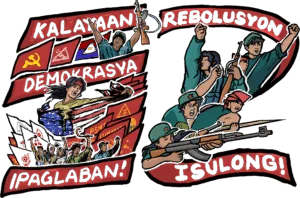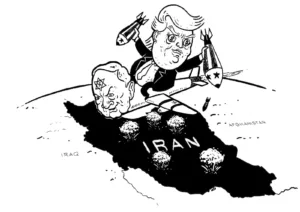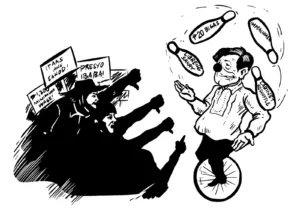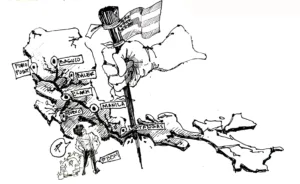 Essay to celebrate the 50th Founding Anniversary of Kabataang Makabayan
Essay to celebrate the 50th Founding Anniversary of Kabataang Makabayan
By JOSE MARIA SISON
Founding Chairman, Kabataang Makabayan
Having been the founding chairman of Kabataang Makabayan (KM) in 1964, and having led it until the necessity for me to go underground in 1968, I feel elated and highly honored to participate in the KM 50th anniversary celebration.This celebration signifies and encompasses all the struggles, sacrifices and achievements of the KM rank and file in the service of the Filipino youth and the entire Filipino people.
In Line with the Revolutionary Tradition of the Filipino People
We wanted to base the KM on the revolutionary tradition of the Filipino people. Thus, we deliberately founded the KM on the 101st birth anniversary of Andres Bonifacio on November 30, 1964. We wished to honor him for having organized the Katipunan and having taken the lead in proclaiming the national independence of the Filipino people against Spanish colonialism.
We drew inspiration from him as the revolutionary father of the Filipino nation, and we were resolved to follow the revolutionary tradition set by the Katipunan and to continue the unfinished Philippine revolution by completing the struggle for national liberation and democracy against foreign and feudal domination. We were sharply aware that US imperialism interrupted the Philippine revolution by unleashing a war of aggression against the Filipino people, making the Philippines its colony after killing hundreds of thousands of Filipinos and proceeding to train its puppets for semi-colonial rule.
We were cognizant of the fact that the Philippines had entered the world era of modern imperialism and proletarian revolution. The working class had become a significant force in Philippine society as the most productive and progressive force. The Communist Party had arisen to become the advanced detachment of the working class to lead the people’s struggle against foreign and feudal domination. It fought heroically against the Japanese fascist occupation and subsequently the US imperialist reconquest of the Philippines.
The founders of KM were highly conscious of the necessary continuity between the old democratic revolution led by the liberal bourgeoisie against old-style Spanish colonialism and feudalism, and the new democratic revolution led by the working class against US imperialism, feudalism and bureaucrat capitalism under the semi-colonial and semi-feudal conditions of the Philippines in the era of modern imperialism and proletarian revolution. Since the beginning, we aspired to carry out the people’s democratic revolution to lay the ground for a subsequent socialist revolution.
Patriotic and Progressive Role and Tasks of KM
The Kabataang Makabayan adopted the role of being the patriotic and progressive vanguard of the Filipino youth. It aimed to build itself as a comprehensive organization of the young men and women from the toiling masses of workers and peasants and the middle social strata. It offered itself as the assistant of the working class as the leading class in the new democratic revolution. It aimed to become the training center of the activists of the legal democratic movement and the future cadres of the revolution.
The founding Congress of the KM set forth a Constitution and Program of Action along the general line of the people’s struggle for national and social liberation. The KM demanded complete national independence, democratic rights and the empowerment of the working people, genuine land reform and national industrialization, social justice, a national, scientific and mass culture and an independent foreign policy for the solidarity of all peoples and countries, peace and development in opposition to imperialism and reaction.
Among the founders of the KM were proletarian revolutionaries and participants in mass actions since 1959. They came from the student movement, the trade union movement, the peasant movements and intellectual circles. They had an understanding of the new democratic revolution as a result of previous studies in the history and circumstances of the Filipino people and in the theory and practice of Marxism-Leninism. They were of the consensus that the victory of new democratic revolution would prepare the ground for a still better and brighter future of the Filipino people in socialism.
Propelling the Mass Movement and Developing Proletarian Revolutionaries
The KM propelled the national democratic mass movement in the 1960s. It aroused, organized and mobilized the students at the secondary and tertiary levels, the young teachers and other professionals, the youth section of the Lapiang Manggagawa and the trade unions; and the youth section of the peasant associations. We organized chapters in schools, factories, urban poor communities and peasant communities.
We conducted study sessions on the general line of the new democratic revolution and on current issues. Among the most interested and most advanced activists, we carried out study sessions on the theory and practice of Marxism-Leninism. We were determined to develop the mass movement by arousing, organizing and mobilizing the youth along the national democratic line of struggle. At the same time, we were determined to develop the proletarian revolutionaries from the ranks of the mass activists. This was in keeping with the role of the KM as the assistant of the working class and its revolutionary party.
We made statements and launched dramatic protest mass actions on current events and issues involving the national sovereignty, democratic rights and social conditions of the Filipino people and the youth. We confronted US imperialism and the ruling system of big compradors and landlords on domestic issues. And we also stood in solidarity with the oppressed peoples of Asia, Africa and Latin America and the peoples in the imperialist countries.
The KM became the most outstanding organization in condemning and calling for the abrogation of such unequal agreements with the US as the US-RP Military Assistance Agreement, the Military Bases Agreement, the Mutual Defense Pact, the Quirino-Foster Agreement and the Laurel-Langley Agreement. We held the puppet government culpable for servility to US imperialism and betrayal of the sovereign rights and interests of the Filipino people.
We exposed and opposed the big comprador-landlord character of the reactionary government. We called for the improvement of the wage and living conditions of the workers, genuine land reform for the benefit of the landless tillers, and for the purpose of national industrialization, expansion of the public school system at all levels, and better study and living conditions of students. We denounced the ever-rising level of unemployment, the falling incomes, the inflated prices of basic goods and services, and lack or dearth of essential social services.
We vigorously condemned the US and its imperialist allies for their acts of military intervention and aggression, and supported the struggles of the people they victimized. We opposed the US-UK Malaysia project, the US-directed massacre of the Indonesian people, the full-blown US war of aggression against the Vietnamese and other Indochinese peoples, and the US acts of intervention and aggression against the Cuban people, Korean people and other peoples in Asia, Africa and Latin America.
Building Alliances with Other Patriotic and Progressive Forces
To facilitate the expansion of the KM in particular areas, regions or nationwide, the KM always built its own reliable strength and amplify this with alliances within definite classes and sectors and on a multisectoral basis. It could recruit workers and form chapters among them by having close fraternal relations with labor federations. Peasant associations also facilitated the rural immersion programs of the KM. The KM maintained alliances with campus organizations and with national student associations, as well as with the teachers and other professionals.
Even before the KM founding, a number of the prospective founders had started to work in the trade union movement and in the Lapiang Manggagawa in 1962. They participated in the work of research and education, organizing unions and supporting strikes. Thus, they were able to develop close relations with the workers and recruit founding KM members from their ranks. They did so much creditable work that the prospective KM chairman became vice chairman of Lapíang Manggagawa and subsequently the general secretary of the Socialist Party.
The prospective founders of the KM also started to develop close links with peasant cadres and the peasant youth in Central Luzon and Southern Tagalog regions in 1963. The prospective KM chairman gave refresher courses in revolutionary studies to the veteran peasant cadres and their children. On the basis of his close relations with the peasants, KM founding members could be recruited from the peasant youth in 1964.
In 1966 the KM chairman became the general secretary of the anti-imperialist united front organization, the Movement for the Advancement of Nationalism, on the strength of Kabataang Makabayan and its close connections with the worker and peasant movements, and with the student movement and progressive intellectual circles. Several big anti-imperialist mass actions were held under the auspices of MAN.
Confronting the Escalation of Oppression and Exploitation
From year to year, the chronic crisis of the semicolonial and semifeudal ruling system worsened during the regime of Marcos. The broad masses of the people were suffering from the escalation of oppression and exploitation. Unemployment was rampant and the prices of basic goods and services were rising. The peasants were groaning under the weight of land dispossession and rising land rent. The student youth were beset by the rising costs of study and living.
The Marcos regime was increasingly violent in reacting to mass protests on domestic issues. When the US wanted to involve the Philippines in the US war of aggression in Vietnam, Marcos readily agreed and unleashed the military and police against the KM-led youth protesting the 1966 Manila Summit of US President Lyndon Johnson with the leaders of partner countries and client states in the Asia-Pacific region. In response, the KM intensified the deployment of urban activists in mass work in rural areas to prepare for people’s war.
The KM spread nationwide. It recruited student leaders from national student organizations and from the upsurge of student strikes. It had members and chapters in all regions and in most provinces, including in the Moro areas of Mindanao and in the BIBAK provinces of the Cordillera. It gave special attention to the national minorities because they continued to be the most exploited and oppressed, and they had resisted foreign domination. It gave political education and training to some who would eventually become leaders of the revolutionary movement among the Moro and Igorot peoples.
Political Education, Propaganda and Cultural Work
For organizing its chapters, the KM always had the OD-ED team. The OD cadre made sure that the organizational meetings were held in coordination with those to be organized and that the chapter was established with the election of officers. The ED cadre made sure that the recruits gained adequate understanding of the general line of new democratic revolution, the most important points in the KM Constitution and Program of Action and the burning issues of the day.
For the purpose of political education, the KM handbook of basic documents was the basic tool in recruitment of members and establishment of chapters. It was reinforced by the publication of the KM Chairman’s book Struggle for National Democracy in 1967. It was further reinforced by Amado Guerrero’s Philippine Society and Revolution in 1969. Each book was avidly read and studied by the KM rank and file.
At the establishment of the KM city, provincial, regional and central leading organs, the KM ascertained discreetly that there was a KM core of cadres who had already studied the basic principles of Marxism-Leninism.
When mass actions were undertaken, local buildup meetings and rallies were held. The slogans were sharpened. The manifestos were formulated and distributed. Agitational street broadcasts were done. The agitational speakers were readied. The KM Education and Propaganda Department developed the writers and speakers for the purpose. To make the mass actions even more interesting and engaging, cultural numbers were performed in the streets and on improvised stages. For the purpose, the KM Cultural Bureau promoted the organization of cultural groups and the development of the performers in various art forms.
Proletarian Revolutionaries against the Lavaite Revisionists
A significant number of KM advanced activists joined the old merger party of the Communist and Socialist Parties like the KM chairman who had earlier joined it in 1962. They constituted the biggest and most conscious part of the party. They studied the theory and practice of Marxism-Leninism-Mao Zedong Thought, criticized and repudiated modern revisionism centered in the Soviet Union, supported the Great Proletarian Cultural Revolution in China, and promoted in the Philippines the general line of people’s democratic revolution through protracted people’s war.
The young proletarian revolutionaries who founded the KM had gotten their revolutionary education in Philippine history and current major issues in the light of Marxism-Leninism since 1959, independent of the old merger party. This party became practically non-existent as early as 1957 when its general secretary promulgated his liquidationist “single file” policy. He took an onlooker’s interest in the rising youth movement only when the anti-CAFA (Congressional Committee on Anti-Filipino Activities) rally occurred in 1961 and never offered any kind of guidance.
When one of the Lava scions, who was divorced from the mass movement and was a full-time employee of the reactionary government, usurped authority from the executive committee and secretariat of the old party in 1966, the proletarian revolutionaries within the KM and senior cadres in the trade union and peasant movement joined up to launch the Rectification Movement in 1966 and to organize the Provisional Political Bureau in 1967. They criticized and repudiated the long history of Lavaite opportunism and prepared for the reestablishment of the Communist Party of the Philippines in 1968.
Further Rise of the Mass Movement
The reestablishment of the Communist Party of the Philippines on December 26, 1968 and the founding of the New People’s Army became publicly known. They served to inspire the mass movement in the national capital region and on a national scale in 1969. Workers’ strikes against oppressive and exploitative employers became widespread. Student protest rallies against the Marcos regime and student strikes against ultra-reactionary school authorities also continued to spread like wildfire. A large contingent of peasants from Central Luzon came to Manila to demand land reform.
The First Quarter Storm of 1970 burst out and was inflamed by the violent dispersal of the protest rallies and marches. At different points in Metro Manila, the youth, the workers and the people in general assembled. In growing columns of marchers, they converged on the center of Manila and rallied in front of Congress, the presidential palace and the US embassy. They ranged from 50,000 to 100,000 in number per weekly mass action. They cried out, “Makibaka, huwag matakot (Fight, don’t be cowed)! People’s war is the answer to martial law!”
The Diliman Commune arose at the University of the Philippines in early 1971. It was ignited by the rising costs of fuel which led to higher costs of study and living. The Marcos regime ordered the police and military to enter the campus. But the students and faculty members resisted by setting up barricades and occupying the buildings and grounds of the university. Mass protest actions by the youth, workers and peasants occurred on a nationwide scale during most of the year.
Marcos Preparations for and Conduct of Fascist Dictatorship
After winning the 1969 presidential elections by means of fraud and terrorism, and inflationary spending of public funds, Marcos showed signs of planning to stay in power indefinitely. He harped on the line that the Philippines was a social volcano and that extraordinary measures were needed. He schemed and encouraged his own political subalterns and the clerico-fascists to call for a drastic change of the 1935 constitution of the Philippines as the way for him to remove the maximum limit of two 4-year presidential terms, and to realize his ambition of becoming a fascist dictator.
In 1971 he masterminded the Plaza Miranda grenade attack on the miting de avance of the opposition Liberal Party. Within a few hours after the incident, he blamed this on the Communist Party of the Philippines and his main political rival Sen. Benigno Aquino Jr., and proclaimed the suspension of the writ of habeas corpus. He ordered the nationwide raids on the offices of the Kabataang Makabayan and other national democratic mass organizations and the arrest of their leaders. The suspension of the writ of habeas corpus was the dress rehearsal for the fascist proclamation of martial law in 1972.
As a result of the 1971 suspension of the writ and the raids and arrests directed against the national democratic movement, the KM accelerated the deployment of its most exposed and “wanted” leaders in the urban underground and in the guerrilla zones. It kept open the Bonifacio Center and its other urban offices but reduced the appearance of KM officers who were in the “wanted list” of the military or who were most vulnerable to arrest. Due to the mass protests spearheaded by the Movement of Concerned Citizens for Civil Liberties, Marcos pretended to lift the suspension of the writ. Even then, the KM prepared itself against the widely anticipated proclamation of martial law, which was done by Marcos formally on September 21, 1972.
Even before 1972, the KM was already deploying the CPP members and advanced mass activists among the KM members to join the New People’s Army or rural mass work to prepare local areas for guerrilla zone development. But after the proclamation of martial law, a far greater number of KM members joined the people’s army and conducted rural mass work. Driven to the underground, the KM came under the supervision of the Preparatory Commission of the National Democratic Front. It became an important part of the process of building the National Democratic Front that began with the promulgation of the 10-Point Guidelines of the NDF on April 24, 1973.
KM Contributions to People’s War and the United Front
The Communist Party of the Philippines owes to the KM its nationwide scale and deep roots among the masses. In the 14-year course of the Marcos fascist dictatorship, KM officers and members became cadres and members of the Communist Party of the Philippines. They occupied responsible positions in the leading and staff organs of the CPP. They became commanders and political officers of the New People’s Army. They organized the various types of revolutionary mass organizations for workers, peasants, youth, women, teachers, health workers, cultural activists, and so on. They participated in building and activating the organs of political power.
The KM officers and members spanned the toiling masses of workers and peasants, the middle social strata and the various sectors. They were in a position to help in the building of the united front at various territorial levels and in various fields of social activity. They were a binding force among the youth from the various patriotic and progressive classes and sectors. The KM became an outstanding component of the National Democratic Front.
Leaders of the Moro National Liberation Front, including Nur Misuari, received their political education and training when they were KM members and leaders. Indefatigably, the KM encouraged the oppressed national minorities to assert and exercise their right to national self-determination. Thus, the Moro and Lumad peoples of Mindanao, the Igorot people, the other hill tribes and the Aetas have taken the revolutionary path.
Overthrow of the Fascist Dictatorship
The KM was a significant force in the 14 years of struggle against the Marcos fascist dictatorship from beginning to end. All over the Philippines, KM officers and members participated in the people’s war to fight the fascist regime and the entire ruling system. They were in the Communist Party of the Philippines, New People’s Army, the underground mass organizations and organs of political power in the countryside.
They maintained and developed urban underground networks. They operated through unexposed activists in the aboveground organizations and institutions. They suddenly appeared and disappeared to make lightning demonstrations, distribute leaflets, paint slogans on walls and paste posters in public places. They conducted surveillance on the enemy forces and provided the necessary intelligence for the armed city partisans.
They were in every effort to revive the urban mass movement where the fascist regime appeared to have silenced the people in the 1970s and early 1980s. They were involved in the open reestablishment of patriotic and progressive trade unions, student organizations, and other types of mass organizations. They were in the anti-fascist alliances. Following the Aquino assassination, they were among the most resolute and most militant activists in the groundswell of the mass movement that eventually toppled the dictatorship.
In so many ways, they made important contributions to the advance of the revolutionary struggle for national and social liberation. They did hard work and made sacrifices in the urban and rural areas. A high proportion of those who were abducted, tortured and murdered by the Marcos fascist regime came from the KM or received their political education and experience from the KM.
Perseverance in the Underground and Long-Term View
After the overthrow of the Marcos fascist dictatorship, the Kabataang Makabayan decided to persevere in the revolutionary underground as one of the major components of the National Democratic Front. Ever since the struggle against the fascist regime, the KM has served as the Communist Youth League. This is in consonance with the commitment of the KM since its founding 50 years ago to be the assistant of the working class as vanguard of the people’s democratic revolution and the training center of the youth for the revolution.
I have covered the tasks and achievements of the KM from its founding in 1964 to fall of Marcos in 1986. The current leadership of the Kabataang Makabayan is in the best position to look back to its history, especially from 1986 to the present, in order to assess and evaluate its record, to set forth the tasks and methods for further advances, and to look forward to greater victories in the future.
There is still a tremendous lot of hard work, sacrifices and militant struggle needed to achieve the basic completion of the people’s democratic revolution through the overthrow of the US-directed ruling system of big compradors and landlords. We can proceed to the socialist stage of the Philippine revolution only after the proletariat and the people have seized political power and have established the people’s democratic state system. From then on, we can proceed to plan and carry out socialist revolution and socialist construction.
But even right now, in having a clear socialist perspective, we look up to the leadership of the working class as the most progressive and most productive force in completing the people’s democratic revolution and carrying out the socialist revolution.
It has the revolutionary theory and the practical experience to confront, fight and defeat the big bourgeoisie. It also has the theory of continuing revolution and the initial practice of consolidating socialism, combating modern revisionism and preventing the restoration of capitalism.
The KM is responsible for the revolutionary education and training of the youth. To uphold the socialist perspective, it must propagate the study of Marxism-Leninism-Maoism. This encompasses the foundational teachings of Marx and Engels in the era of Marxism, the further teachings of Lenin, Stalin and Mao on winning the proletarian revolution and building socialist society in the period of Marxism-Leninism, and the initial attempt by Mao to consolidate socialism, combat modern revisionism and prevent capitalist restoration in the period of Marxism-Leninism-Maoism.
The protracted and ever worsening crisis of the world capitalism, characterized by the boundless greed of the monopoly bourgeoisie and financial oligarchy under neoliberalism and mounting state terrorism and wars of aggression, urges us to struggle ever more resolutely and militantly for the completion of the people’s democratic revolution and proceed to the socialist revolution.











